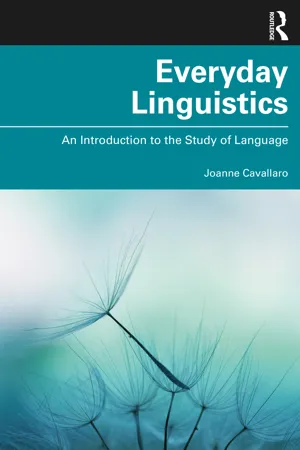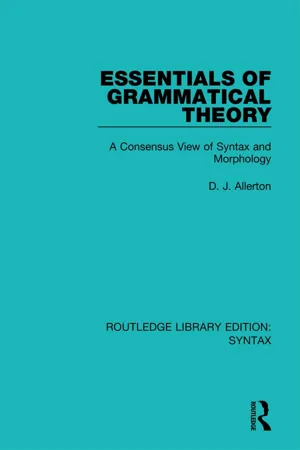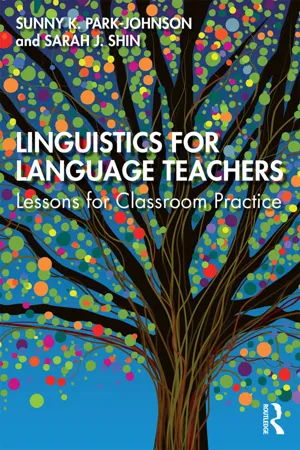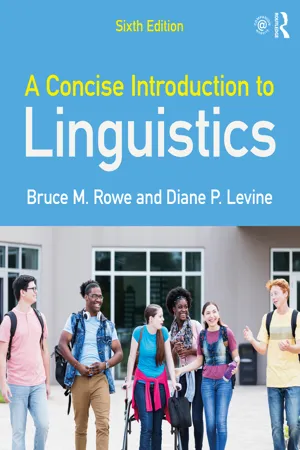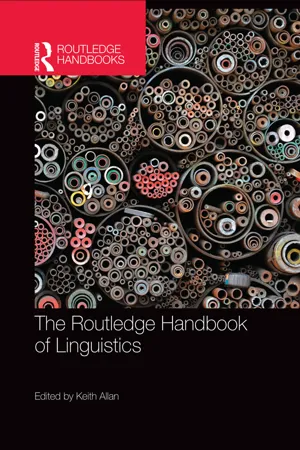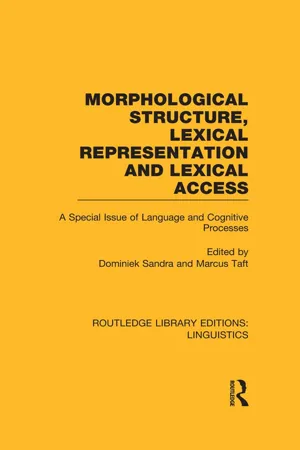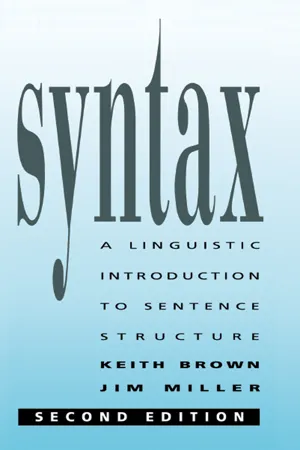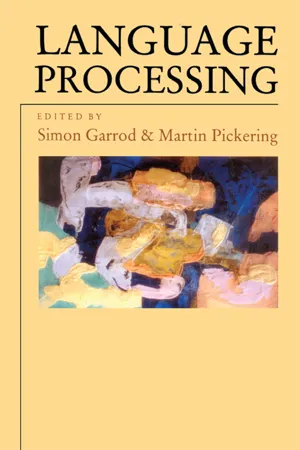Languages & Linguistics
Lexical Morphology
Lexical morphology refers to the study of the structure and formation of words in a language. It focuses on how words are built from smaller units called morphemes, which carry meaning or grammatical function. This field examines processes such as affixation, compounding, and derivation to understand how words are created and how their meanings are modified.
Written by Perlego with AI-assistance
Related key terms
10 Key excerpts on "Lexical Morphology"
- eBook - ePub
Sign Languages
Structures and Contexts
- Joseph Hill, Diane Lillo-Martin, Sandra Wood(Authors)
- 2018(Publication Date)
- Routledge(Publisher)
Chapter 3Morphology
In this chapter, we continue our discussion of sign language grammar, turning to the domain of morphology . Morphology is the study of words, so in this chapter, we will look at how words are made in American Sign Language (ASL). We will discuss the ways that new words are formed, how words are modified, and the role of iconicity in ASL. The chapter also includes discussion of the way that the signing space is integrated in signs, and some morphological devices that seem to be special to sign languages.3.1 What is morphology?
Morphology is the branch of linguistics that studies how words are formed from component parts. A morpheme is generally described as a consistent pairing of form (e.g., a sequence of sounds or a combination of handshape, location, and movement) and meaning, but there are morphemes that change their form in different contexts as well as those that don’t seem to have a consistent meaning.In spoken languages such as English, there are many words that are themselves a single morpheme, such as “cat,” “elephant,” “and,” and “behind.” Bear in mind that in English, a morpheme can have one, two, or more syllables – they are completely different notions. Words that contain two morphemes include “cats,” “walking,” and “rewrite.” The plural marking -s on “cats,” the progressive -ing on “walking,” and the prefix re- in “rewrite” contribute an additional morpheme that either makes a word fit a particular context (the usual role of inflectional morphology), or changes the word into a new type with a new meaning (the usual role of derivational morphology). In addition to inflectional and derivational morphology, word formation is a component of morphology. Word formation encompasses the various ways that new words are added to a language. We will discuss sign language examples of each of these types of morphology in reverse order in the subsequent sections. - eBook - ePub
Everyday Linguistics
An Introduction to the Study of Language
- Joanne Cavallaro(Author)
- 2023(Publication Date)
- Routledge(Publisher)
CHAPTER 3 Morphology Word histories and structureDOI: 10.4324/9780429269059-3First glance- How do we put words together?
- Word formation processes:
- · When is borrowing theft?
- Word structure: Morphemes
- Derivational and inflectional morphemes
- Grammatical meaning
- Morphology in other languages
- Hierarchical structure of words
- Acquiring words
INTRODUCTION
Most people probably think of words as the basic, most important part of a language. When we learn a foreign language in school, aren’t we asked to memorize all those words at the end of each chapter? If we do memorize them, we’re often not much further along in learning to speak the language, though, because every language consists not only of a lexicon—a vocabulary—but also a phonological system, a morphological system, a syntactic system, and a grammar for putting them all together. Each system has a structure that we’ll examine in the following chapters. Here we’ll start with those words by examining morphology, the study of words and their structure.What is it we know when we know a word? We know its meaning or meanings, its pronunciation or sign, how it’s used in a sentence, and how to use it appropriately. We know that, even within the same language, the word for something in one area may be totally different in another area. A submarine sandwich (or sub) in Minnesota, for example, is a hoagie in Philadelphia and a hero in San Francisco. We know that words vary across time as well as space; that is, they come and go. How many of you still speak of an ice box, a davenport, or consumption (refrigerator, sofa, and tuberculosis, respectively) or use slang terms like groovy or phat or rad?We know, even if we’re not aware of it consciously, that words are made up of separate parts that have meaning. Doors, for example, is made up of two parts, door and an {s} that means it is plural. We also know that each word is a particular part of speech (a noun or a verb, for example), what linguists call lexical categories - eBook - ePub
- Kristin Denham, Anne Lobeck(Authors)
- 2018(Publication Date)
- Routledge(Publisher)
4 The study of words MorphologyLet’s now consider how we study speakers’ unconscious knowledge of word structure. In Chapter 2 , in the ‘Our knowledge of grammar’ section, we briefly discussed how our knowledge of word structure, or morphology, includes knowledge of morphemes, or parts of words, and of affixation (suffixes and prefixes in English for example, and the roots and words they attach to). We also have knowledge of word formation rules such as clipping, blending, backformation, compounding, etc.As we will see in this chapter, languages don’t necessarily share the same morphological rules. Consider, for example, one type of word formation that doubles a part of the word (called reduplication) that occurs in Lushootseed, a language of the Pacific Northwest (adapted from Hess & Hilbert, 1995):ʔálʔal house ʔáʔálʔal hut ʔúqw’ ud pull out ʔúʔúqw’ ud pull part way out híwil go ahead híhíwil go on ahead a bit q’íxw upstream q’íq’íxw a little bit upstream The first two sounds of a word are doubled in order to make a diminutive: the ʔá of the word for house is doubled to make hut: ʔáʔálʔal.As we will also see in this chapter, there is much more to the study of morphology than making words. In fact, the question What is a word? is actually quite difficult to answer, because not all languages build words in the same way, yet speakers share some kind of common knowledge that allows them to recognize what is and what is not a possible word in their language.MorphemesA morpheme is often described as the smallest unit of meaning in a word. This suggests that there are two morphemes in the word pancake, namely, pan and cake, both of which have rather obvious, recognizable meanings, and both of which are words by themselves. Other morphemes have meaning too, though perhaps not in the dictionary sense. English speakers would probably all agree that there are three morphemes in waspishness (wasp, -ish, and -ness). We can say that the morphemes -ish and -ness have meaning because we recognize them as parts of words we easily combine with other parts to create other words, such as pinkish and happiness. We also know that although -ish and -ness can attach to adjectives such as pink and happy, these suffixes can’t attach to verbs such as run or work to create *runnish or *workness. So, although we might have difficulty defining the term word - eBook - ePub
Essentials of Grammatical Theory
A Consensus View of Syntax and Morphology
- D. J. Allerton(Author)
- 2016(Publication Date)
- Routledge(Publisher)
elelýkete, ‘you (plur.) had unfastened’. Such a description at least recognizes the problems of segmentation.Figure 85Lexical and inflectional morphology
Earlier in this chapter we equated Lexical Morphology, i.e. the study of the formation of new lexical items, with word-formation and distinguished this from inflectional morphology, through which a single lexical item, a lexeme, can be inflected for a variety of grammatical subcategories, such as number, case, tense. Lexical Morphology subdivided into compounding, which gave new lexemes by combining two stems (e.g. darkroom, football), and derivation, which did so by affixation to a stem (e.g. unkind, florist). But both branches of Lexical Morphology agree in making a contribution to the vocabulary or lexicon of a language. As such they are more “particularistic”, dealing with individual words, whereas inflection is of general applicability and integrates with general syntactic patterns.The “particularistic” quality of word-formation comes out in a number of ways. We expect an inflectional affix to be usable with any appropriate lexeme in the language: so that all English common nouns, for instance, must have a plural form, even though some have irregular forms, and some would have a zero allomorph – at least they can all occur in the plural. Even MASS nouns have a plural with the meaning ‘kinds of’, e.g. We are talking about two different milks. Derivational affixes, on the other hand, are rarely so predictable. Take, for example, the English suffix -eer, which forms animate nouns from noun stems, e.g. mountaineer, engineer, profiteer (which have also become verbs by zero-derivation); it is unable to produce words like *hilleer, *motoreer, *advantageer - eBook - ePub
Linguistics for Language Teachers
Lessons for Classroom Practice
- Sunny Park-Johnson, Sarah J. Shin(Authors)
- 2020(Publication Date)
- Routledge(Publisher)
4 MorphologyThe Analysis of Words
4.1 Introduction
So far in this book, we have seen how individual sounds are produced (Chapter 2 ), and how sounds pattern within a language to form meaningful utterances (Chapter 3 ). In this chapter, we proceed to examining a slightly larger linguistic unit—words. Words are a crucial part of our mental grammars. Without knowledge of words, we would not be able to get our meanings across to other people. Unlike phonemes and syllables, which operate only at the level of sounds, words carry meaning in addition to sounds. Words are also permanently stored in a speaker’s mental dictionary called lexicon. This permanence distinguishes words from phrases and sentences, which are pieced together with words as needed and then discarded when the need for them disappears (we will discuss sentence structure in Chapter 5 ). Quite simply, words are the building blocks of communication.What is a word? What does it mean when we say we know a word? Knowing a word means knowing both its sounds and its meaning. Every speaker of English knows that measure is an English word, as are measurement, measuring, measurable, and immeasurable. However, even though street is an English word, English speakers know that they cannot say any of the following: streetment, streeting, streetable, instreetable. How do English speakers know that adding -able to measure results in another word, but adding -able to street does not? Morphology tries to capture this knowledge, which is largely subconscious.Morphology is the study of the internal structure of words—how words are formed and what their relationships to other words are in the same language. It describes which meaningful pieces of language can be combined to form words and what the effects of such combinations are on the meaning or the grammatical function of the resulting word. For example, adding -able to measure modifies the grammatical function of measure, a verb, to an adjective, and it does so in the same way when attached to do (doable), or manage (manageable). Similarly, adding re- to type changes the meaning of type to indicate repetition, and it does so in the same way when added to generate (regenerate), or furbish (refurbish) - eBook - ePub
- Bruce M. Rowe, Diane P. Levine(Authors)
- 2022(Publication Date)
- Routledge(Publisher)
Three kinds of synthetic language types were discussed: inflectional, agglutinating, and polysynthetic. In reality, most languages mix the typological principles to various degrees.Morphemes may have different phonemic shapes. The phonemic shape that is used depends on the sound characteristics of the morphemes being combined. Because both morphology and phonology are involved in these subconscious decisions, the study of them is called morphophonemics.New words are constantly entering languages. The processes of compounding, blending, acronym formation, foreign word borrowing, clipping, derivation, back-formation, using proper names, and using trade names are some of the more common ways that new words are formed.Words can be divided into types and subtypes depending on their meaning, how they function in a sentence, how they are inflected, and other criteria. One system of doing this, dividing words into the lexical categories, was described in Table 4.1 .Suggested reading
- Aronoff, M., and Kirsten Fudeman, What Is Morphology? 2nd ed., Malden, MA: Wiley-Blackwell, 2011.
- Barnhart, Robert K., and Sol Steinmetz, eds., Chambers Dictionary of Etymology , Edinburgh: Chambers, 1999.
- Bauer, L., Introducing Linguistic Morphology , 2nd ed., Washington, DC: Georgetown University Press, 2004.
- Coates, Richard, Word Structure , London: Routledge, 2000.
- Crystal, David, Words, Words, Words , New York: Oxford University Press, 2007.
- Haspelmath, M. and Andrea D. Sims, Understanding Morphology
- eBook - ePub
- Keith Allan, Keith Allan(Authors)
- 2015(Publication Date)
- Routledge(Publisher)
werkers ‘workers’ has the morphological structure seen in (4).(4) werk-er-s work-agent-plural ‘workers’This is a simple example of the morphological analysis of a complex word, and presented in a form that follows the conventions of interlinear morphemic glossing. The first line presents the internal constituency of the complex word. The second line provides a morpheme by morpheme glossing, and the third line gives a paraphrase of the meaning of the linguistic expression. The rules for glossing are codified as the Leipzig glossing rules.3Morphology is a subdiscipline of linguistics with its own textbooks, reference works and journals. Two recent textbooks are Haspelmath and Sims (2010) and Booij (2012). Reference works are Spencer and Zwicky (1998) and Booij et al. (2000, 2004). A recent reference work for English morphology is Bauer et al. (2013). Two journals devoted to morphology are Morphology (1988–, published by Springer), and Word Structure (2008–, published by Edinburgh University Press).7.2 Types of morphological operation
Cross-linguistically, the most common form of word formation is compounding, the combination of two or more lexemes into a complex word, such as the English word songbook composed of the nouns song and book . Many languages also make use of derivation, the process in which bound morphemes (affixes) such as –er are attached to a base word. These two mechanisms are instances of concatenative morphology, in which complex words are created by means of the concatenation, or stringing together, of affixes and words. In addition, languages may also allow for deriving new words from existing ones by only changing the syntactic category of a word. This is referred to as conversion. Examples are the English verbs to skype and to text mentioned above which are verbs derived from the nouns skype and text respectively, without this derivational relationship being marked overtly by means of an affix. In English, the conversion of nouns to verbs is a very productive process. Conversely, nouns may be derived from verbs in this way, as is illustrated by nouns such as fall and help - eBook - ePub
Morphological Structure, Lexical Representation and Lexical Access
A Special Issue of Language and Cognitive Processes
- Dominiek Sandra, Marcus Taft, Dominiek Sandra, Marcus Taft(Authors)
- 2014(Publication Date)
- Routledge(Publisher)
The Morphology of the Mental Lexicon: Internal Word Structure Viewed from a Psycholinguistic Perspective Dominiek SandraA conceptual analysis is made of several ways in which the morphological structure of words might enter their lexical representation and/or processing. Economising on storage space seems an attractive option in light of the linguistic definition of the morpheme. However, for several word types, problems would arise in the mapping of morphs onto morphemes and of morphemic meanings onto whole-word meanings. Moreover, economy is a legal option, which might not be available to the mental lexicon. Alternatively, morphs might be put to the purpose of increasing lexical access speed, as proposed by Taft and Forster (1975) in their prefix-stripping model. It is demonstrated that such a view strips morphology from virtually all of its linguistic aspects. Furthermore, the prefix-stripping model would decrease rather than increase the access speed for several types of prefixed words in a number of languages. Linguistically interesting hypotheses are instantiated by the view that affixes are used for providing the syntactic processor with structural information and by the proposal that morphologically organised representational structures are the result of an encoding/retrieval scheme developed at the time of lexical acquisition/learning. Finally, morphemic units might be involved in processing as the result of the frequency of their letter cluster. It is a remarkable fact in current psycholinguistic research on morphology that, despite the linguistic nature of the study object, the majority of studies addressing it have been concerned with access representations rather than intra-lexical, linguistically relevant representations.INTRODUCTION
As morphemes are considered to be the structural units of words, psycholinguists studying the word recognition process sooner or later had to venture into the linguistic domain of morphology. Indeed, some initial explorations by Gibson and Guinet (1971) and Murrell and Morton (1974) in the early 1970s were soon followed by the seminal research of Taft and Forster (1975; 1976). This work led to a steady interest in the topic and generated a large literature. - eBook - ePub
Syntax
A Linguistic Introduction to Sentence Structure
- Keith Brown, Jim Miller(Authors)
- 2020(Publication Date)
- Routledge(Publisher)
*a-re-fura, *be-fura-a, and so on, are impossible. From a syntactic point of view it is clearly most illuminating to postulate rules like:14 Verb → Asp VAsp → {hab, prog, fut, pret, perf}which associate each verb stem with an aspect marker and place it before the verb. Realization rules will then ensure that the habitual verb form has no affix, the preterite has a suffix, and all the other forms have a prefix. It is not possible to devise rewrite rules that maintain the generalization that all five terms belong to the same category of Aspect and also to derive the morphemes in the correct surface order (the reader is invited to try).We conclude that the compositional structure of words is to some degree independent of the syntactic description of a sentence and that it is necessary to distinguish between the morpheme – an abstract unit whose distribution is accounted for by the syntax – and the morph – a substantial unit whose distribution is not wholly accounted for by the syntax.NotesTechnical terms
bound form lexical morpheme derivational morphology morph free form morpheme grammatical category morphosyntactic word grammatical morpheme orthographic words homograph phonological words inflectional morphology potential pause item and arrangement realization lexeme word form lexical category 1 This terminology also allows us to talk sensibly about some traditional problems. So, for example, ‘homography’ arises when two different words (= lexemes) are orthographically represented by the same word (= word form). Thus the same word form mace may realize either the lexeme MACE(1) with the sense ‘spice’ or the lexeme MACE(2) with the sense ‘staff of office’ – a fact usually recognized in dictionaries by according each lexeme a different entry.2 In section 12.3 we distinguished between ‘word and paradigm’ and ‘item and arrangement’ models of morphology. In the former the grammatical word will generally be the head lexeme and its associated features (e.g. laughed:LAUGH[past] , or LAUGH[past part] ); in the latter the grammatical word will be a string of morphemes (e.g. laughed - eBook - ePub
- Simon Garrod, Martin Pickering, Simon Garrod, Martin Pickering(Authors)
- 2016(Publication Date)
- Psychology Press(Publisher)
affixes. This type of combinatorial approach assigns a crucial role not just to stem morphemes but also to affixes; the derivational suffixes and prefixes which combine with stems to form new words, often with very different syntactic and semantic properties. These are powerful operations, and any morphologically based theory of lexical representation will have to accommodate them. But although linguistic accounts of morphology have had a lot to say about affixes, there has been very little experimental work on their mental representation. Psycholinguistic work, ours included, has been much more interested in the properties of stems. But until we understand more about affixes, and about how they fulfil their key role in lexical representation and processing, any theory of the mental lexicon will be incomplete; especially any theory arguing for a morphemically decomposed lexicon organised around combinatorial operations.FIG. 4.3 Inflectional morphology: Cross-modal priming between regular and irregular verbforms and their stems. Regular stems (e.g. jump) are preceded by regular present (jumps) and past tense (jumped) forms. Irregular stems (e.g. give) are preceded by regular present (gives) and irregular past tense (gave) forms.As a first step in this direction, we addressed the question of whether derivational affixes are independent entities in the lexical system. These are all bound morphemes. This means that they cannot, unlike free morphemes, stand alone as words in English. There are no words ness or re, corresponding to the -ness in darkness or the re- in rebuild. These are all morphemes that can only occur in conjunction with a stem. But does this also mean that they cannot stand alone as cognitive elements, represented separately from the stems to which they apply?It follows from our decompositional approach to lexical representation that this should be the case; that affixes are independently represented as morphemic elements. On a combinatorial view, the -ness in happiness should be the same as the -ness in darkness; the re- in refill the same as the re- in rebuild, and so on. This predicts that we should be able to get priming between these forms. Darkness should prime happiness, in much the same way, and for the same reasons, as two forms sharing the same stem. Furthermore, any such effects should interact with productivity—whether an affix is still being used in ordinary speech to form new words. Productive affixes like -ness or re- are more likely to be independently represented—and therefore primable—than affixes like en- (as in enslave) or -th (as in depth
Index pages curate the most relevant extracts from our library of academic textbooks. They’ve been created using an in-house natural language model (NLM), each adding context and meaning to key research topics.

